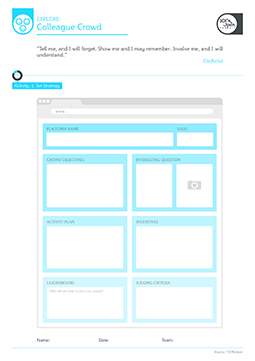Colleague Crowd
“Tell me, and I will forget. Show me and I may remember.Involve me, and I will understand.”
Confucius


This tool is a version of a crowdsourcing platform used for including our colleagues in idea generation. A Colleague Crowd can also be used for building an agreed strategy, discovering best practice, uniting staff around a particular challenge or finding stories for communications campaigns.

The first step is to build or hire a platform. We have found it is cost-effective to hire a specialist platform that is well-designed and more engaging for staff in innovation than existing intranet systems (See Crowdsourcing Platform).
Colleague Crowds work best when they are highly visual and cut through the clutter of emails and meetings. We pick an engaging and simple platform where colleagues can upload and share photos, audio and video easily.
Colleague Crowd members will respond positively to comments and encouragement. A good facilitator will draw attention to interesting threads of conversation in real time for exploration and development (see Facilitation Guide). The facilitator feeds the results of the challenge back to the community. We need to tell our crowd who will take their ideas forwards and how.
We use the tool template to think about how our challenge will be structured, answering these questions:
Describe what we want colleagues to help us with in plain language. Communicate clearly to get busy colleagues to spend time on the site.
• What’s the background to the challenge?
• Why is it important for them to help us?
• What are we going to do with their ideas?
It is important to come up with an Interesting Question (see Challenge Designer) that is jargon-free, compelling and precise. It needs to be interesting to the crowd to ensure enthusiastic participation and interesting to the Challenge Holder to ensure enthusiastic uptake of the winning ideas.
Firstly we decide how long we want the community to exist. Colleague Crowds can run for over a year or just a few weeks. Here’s a plan for a typical three-month crowd:
• Offline launch event to generate awareness and test the Interesting Question.
• Communicate the programme using posters, display stands, T-shirts and ‘Challenge Road Shows’ in unexpected locations
• General discussion about the key issue and why it’s important
• Sharing existing innovation projects not widely known
• Ideas prize challenge
We need to vary the format of activities to keep participants stimulated. Consider alternating discussions with polls, photo uploads, rating exercises and ideas challenges.
Most crowdsourcing platforms are gamified with leaderboards and points awarded for activities such as submitting ideas, commenting and voting on others’ ideas. Will we give prizes for the best contributions? Dinner with the Chief Exec? Or the latest iPad?
Which departments, divisions or regions will we invite to participate? Could we include suppliers, agencies or anyone else close to us?
We need to plan how to judge the best ideas or contributions. Voting is a key part of what makes crowdsourcing platforms work. Will we enable the community to vote on each other’s ideas and if so how many of these will we take forward? Will we convene a panel of senior or even external judges to agree which ideas are best? We will need to publish the judging procedure to make the process open and transparent. This encourages better quality ideas.
You must be logged in to download this tool
You must be logged in to download this worked example
2014 - 100%OPEN LTD